Sichuan pepper also known as Szechuan pepper, Szechuan peppercorn, or Sichuan peppercorn is an important and popular spice used in China, especially in Sichuan cuisine. And recently some readers from USA told me that it is called Chinese prickly ash as well in the US. High quality of Sichuan pepper is named as one of the two hearts of thousands of Sichuan style dishes. And it is one of the most essential ingredient for Chinese five spice powder.
An overall introduction about Sichuan pepper (Szechuan pepper)
What are the main types of Sichuan pepper?
I have done some little research and find that the most popular Sichuan pepper spice is 大红袍, red Sichuan peppercorn outside China. In fact, there are two main popular types in China: red Sichuan pepper and green Sichuan pepper(usually referred as Ma Jiao instead of Hua Jia in China). The most famous red Sichuan pepper is 大红袍 (Da Hong Pao) and the most famous green Sichuan pepper is 九叶青.
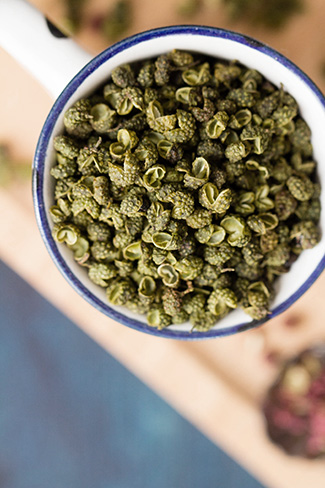
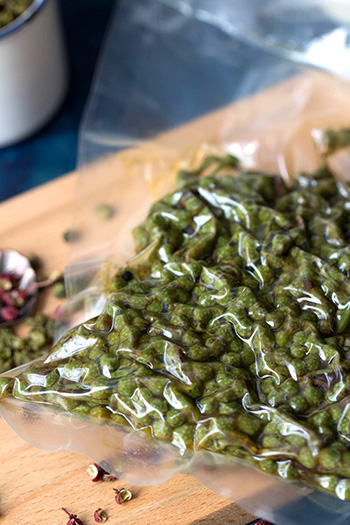
Why it is named as Sichuan pepper?
The name Sichuan pepper many cause some misunderstanding about where it has been planted. Is it Only in Sichuan province? In fact, many of the Northern provinces in China including Shanxi, Qinghai and Shandong also planted Sichuan pepper. In Chinese Traditional Medicine, Huajiao is usually referred to those grown in the highland in Northern provinces. However Huajiao in Sichuan peppercorn or known as Chuan Jiao in Chinese is believed to be the most popular ones in kitchen.
How Chinese people use Sichuan pepper?
Huajiao is believed to be one useful spice in Chinese Traditional Medicine for the purpose of dispelling cold and removing humidity in Human body. The medicinal benefits of Sichuan pepper initially caused its kitchen popularity. Usually there is high humidity in mountainous region of Sichuan province. And Sichuan peppercorn (used to be wide peppercorn grown in the mountainous) is almost everywhere; people begin to use it in daily cooking.
Sichuan peppercorn can be mixed with salt—Szechuan pepper salt, which has been used as a popular seasoning throughout the country. You can check more about this flavor here salt and pepper shrimp.
Sichuan peppercorn oil with strong flavor of Sichuan pepper: it is not spicy at all, but extremely popular in Sichuan cuisine used in many cold dishes or salad. We call this as Ma oil. Usually, fresh green pepper or red pepper is simmered with oil over really slow fire for around 1 hour so the oil absorbs the fragrance of the peppercorns.
Sichuan peppercorn is used in many other mixed spices or seasonings include Chinese five spice powder and my favorite Sichuan style hot pot seasonings.
I get several large bags of really high quality Sichuan peppercorn back to my current living place for the purpose of the restaurant style Sichuan hot pot, expected by lots of readers of a long time. I am sorry for the delay, but finding the right ingredients really consumes time!
The secret weapon of Sichuan style hot pot seasoning is fresh green peppercorn (藤椒) used during the simmering process. It will give the soup base a unique and intense numbing sensation around the mouth (Ma feeling). We usually use both fresh ones along with dried ones, as the dried Sichuan peppercorn will be responsive for the long lasting numbing feeling.
Sichuan pepper Buying and Sourcing Tips
It is really hard to distinguish high quality over low quality if you never tried freshly pickled high quality Sichuan pepper. Or you can directly buy Sichuan peppercorn on Amazon . However there are still some tips I would love to share. The principle is freshly pickled ones are best as the fragrance will fade away along with time.
Observe the color:
Newly harvest Sichuan peppercorns have brighter colors. For red Sichuan peppercorn, it is bright brownish red but not brown. For dried green Sichuan pepper, you should at lest see green in the color instead of a lifeless dark color.
High quality Sichuan peppercorn usually has whole seeds instead of broken pieces.
Smell it: You can slightly smell the strong aroma from high quality Sichuan pepper even outside of air tighter bags(expect vacuum package). When getting close, the taste should be very strong.
Taste it: When used in dishes, you can easily taste the Ma feeling out even with just several whole seeds.
Dishes featured Sichuan Peppercorn
Mapo tofu
Kung Pao Chicken
Sichuan Peppercorn Chicken
Water-mouthing Chicken
By the way, if you get any questions or suggestion, please drop me a comment.

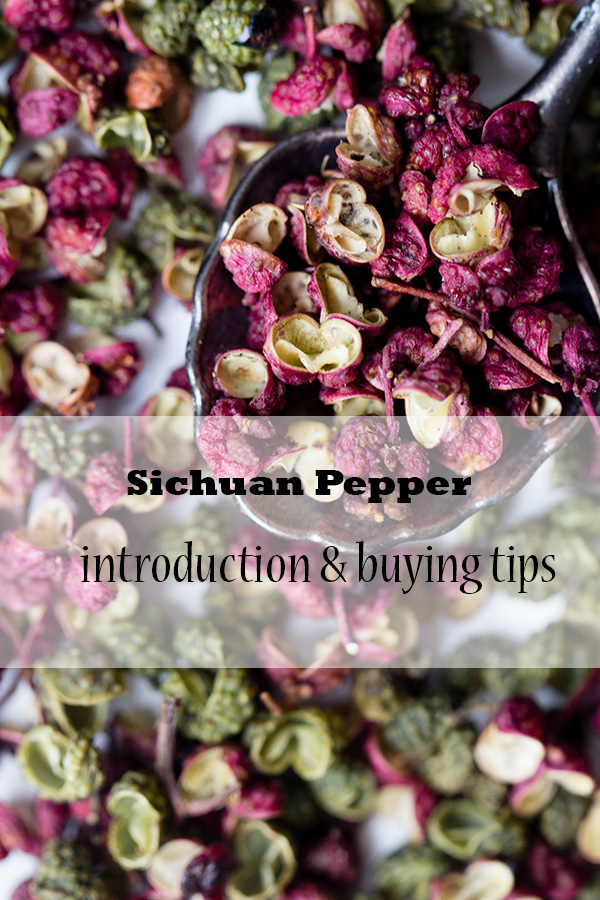
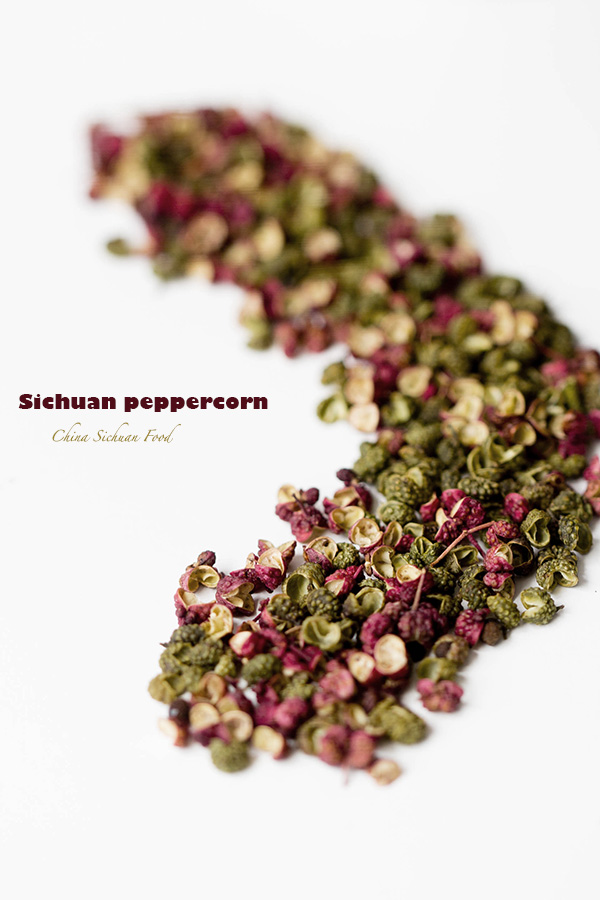
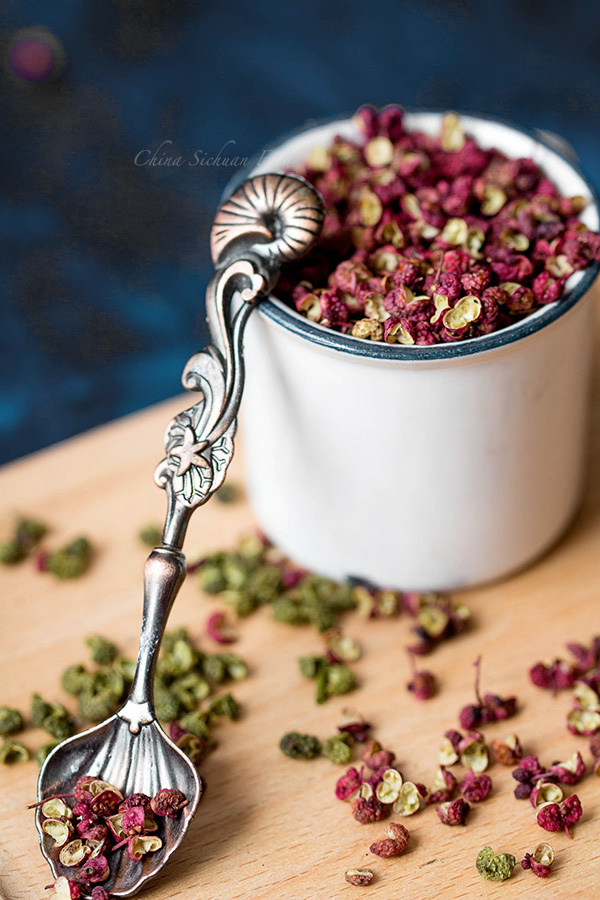
I love this Pepper and your pictures! 😉
Thanks Margarida, this is my favorite spice.
Hello Elaine,
I’m happy I found your blog, I live in Finland and I’m learning to cook chinese food. I bought some sichuan peppercorns few years ago (after a long search). They have lots of dark, round, very hard seeds in them. I’m wondering what to do with the seeds, pick them out or try to grind them together with the red husks. Do you have any advice?
Hi Raijia,
The seeds itself does not provide excellent taste. So I would suggest picking them out. The high quality Sichuan peppercorn I found in my hometown is free of those dark seeds. Next time, you can ask me to purchase some for you.
Hi Elaine,
Thank you for the quick reply. I’ll send you a message in facebook :).
I loved your Szechuan cabbage recipe – I tried it last night and it came out great! The balance of flavors is terrific. Here in the US, I had trouble finding Szechuan peppercorns in the local Chinese market because they were called something different – Chinese prickly ash.
Hi Gwyneth,
Thanks for your information. I will update it soon. And lovely feedback!
Hi Elaine,
First of all, I want to say I love your blog!
I’ve prepared many of your recipes, and they all turned out fantastic.
You’re a great teacher.
Thank you for providing me with the way to bring my favourite cuisine into my own home,
so I can have it whenever I want!
I lived in Macau (Aomen) for 8 years, and there were some great, simple Sichuan restaurants there,
but now I’m in London, and the nearest Sichuan place is a long way away (and too expensive!).
A question about sichuan peppercorns: I notice in your photos, the “shells” are all open, and there are none of the hard, black kernels inside. I know the good flavour comes from the papery shells of the peppercorn and the black insides are not desireable. The first brand that I bought had lots of the black kernels inside. As I’m sure you know, they are crunchy, like eating sand, but not hard enough to break teeth or anything, just a little unpleasant. I want to know if it is a sign of low quality to have the black kernels included? Should I try to find another brand that is more “cleanly” separated? I just found a new brand that looks to have a much better red colour, so I’m hopeful it’s a better one, but I haven’t opened it yet.
Thanks again for all your work on this blog.
Ray
PS: Sorry, I just noticed I am repeating the same question asked by Raija! I will continue the search for “cleaner” peppercorns! Still, I’ve been meaning to thank you for the blog, anyway, for quite some time. Keep up the good work!
PPS: Sorry, one more question: I remember you said in your Peppercorn Chicken article that you had a Sichuan pepper tree in your back garden when you were young. I found out that I can order a small potted one delivered to my flat from a plant nursery here in the UK, so I’ve been dreaming of having my own source for fresh peppercorns out on my balcony. Can you tell me how much of the spice I could expect a young, small bush to produce? Does the fruit come out year-round or only once a season? For my part, if I decide to get one, I’ll let you and your readers know how it goes.
Hi Ray,
This is really a wonderful idea!!!! In fact, my mom have one in the backyard now. And we have hundreds of wild trees in the large mountain near my old house in the country.
Usually the tree will begin to blossom and yield fruit after 3 years of growing, started with a small amount. And starting from the fourth year, you will get a large amount around 10-15 grams fresh ones. Then you need to dry them.
The fruit come after May and will be mature around June and September based on the specific variety.
Hi Ray,
Thanks for your kind words. Personally I do not like Sichuan peppercorn with the small black kernels because usually they are tasteless. However we cannot judge the quality of the Sichuan pepper based on whether they have the kernels inside. They may have the same strong taste.
We can make sure the treating is incomplete, which might be caused by the poor processing technology. So I would suggest to search for those without kernels, as they will pure taste.
When do you use dried green or red peppercorns? Are they interchangable?
Hi Kerri,
Yes, for dried green ones and red ones, they are interchangeable for most daily cooking cases (expect some unique dishes calls for green ones). In fact, I use dried red pepper more than green ones because its taste lasts longer.
Thank you for this thorough primer on Sichuan Pepper.
You are the most welcome!
Hi Elaine ,
I love your blog, your pictures make my mouth water !
I’m also growing a Sichuan pepper tree in my backyard, this year will be my first (very small) harvest.
do you know the blue peppercorn (蓝椒) they talk about in this video ?
https://youtu.be/V23cDPiey0Q?t=3m21s
Hi Sub,
Thanks for your kind words. As for the 蓝椒 they talked about in the video, I think it is not blue. This is a small brunch from plantation area named as 盐源.
Hi elaine. May i know how to dry the sichuan pepper and how to buy it to europe and america? I’m a beginner in bussiness. Thank you
Hi lucky,
Food importing and exporting might be quite complex. I can help to source good quality Sichuan pepper if you need a larger batch.
I absolutely love your blog! I’ve made many dishes already and they have been quite tasty, but I have a question about how to bring out the numbing feeling from the seeds. I live in Taipei and can find dried red peppercorns at the local market as well as the supermarket. Upon opening the bag, the seeds have a very strong smell which is lovely, but when I cook with them, no matter how many seeds I put in, I can never get the numbing/tingling feeling on my tongue. I’ve tried cooking with them whole, ground, and I’ve bought store-bought ground peppercorns, but with no success. I can taste the flavor of the seeds, but just no tingling feeling. What am I doing wrong? Please help!
Hi Adam,
Small amount of Sichuan Peppercorn can only add extra flavor but not strong numbing feeling. However it is quite easy to get numbing taste by using a larger amount. Can you tell me how you cooked them? I would suggest you tasting the ground powder directly. You should have the numbing feeling.
Hi Elaine, great photos and info! These peppercorns looks amazing. I’ve only been able to get fresh ones once, in NYC. Sadly I’ve been unable to find great peppercorns even living in Saigon. Do you think they would grow here? its very humid and rains a lot.
If it is humid, it might be a great idea. Sichuan has the largest production of Sichuan peppercorns and we are having lots of mountains with high humidity.